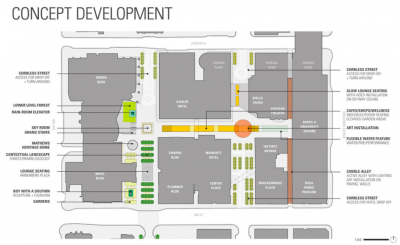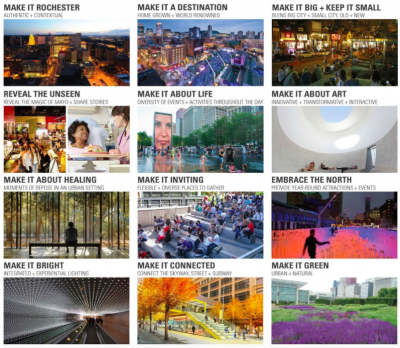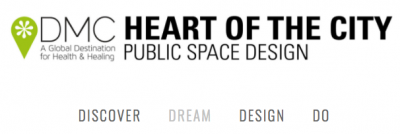
From Discover to Dream, the Destination Medical Center’s Heart of the City public space design team is taking their direction from you.
On March 9, the design team invited community members to take part in the second phase of the design process at a Community Workshop at the Rochester Art Center. More than 130 people attended the 2 ½ hour interactive event.
“The turnout was great,” says Adam Ferrari, owner of the Rochester-based architecture and design firm 9.SQUARE and a member of the design team. But what struck Ferrari was the engagement by the group. “With events like this, it usually goes one of two ways,” he says. “People either react negatively – or they roll up their sleeves and get to work.” This group, according to Ferrari, did the latter.
“It was a high-energy group,” says Patrick Seeb, DMC’s director of economic development and placemaking. “They demonstrated a great deal of creativity.”

Workshop attendees were divided among twelve tables, each focused on one of the project’s Design Principles – “Make It Big + Keep It Small,” “Reveal the Unseen,” and “Embrace the North,” to name a few. With guidance from design team facilitators, table members helped to create a “design scorecard” that clarified what will make the resulting design successful.In many cases, ideas suggested at the tables overlapped, reinforcing the principles and design concepts being presented. “There was support for many bold ideas,” says Seeb, including rethinking 1
In many cases, ideas suggested at the tables overlapped, reinforcing the principles and design concepts being presented. “There was support for many bold ideas,” says Seeb, including rethinking 1st Avenue as a pedestrian space, creating a more heavily programmed Peace Plaza, and introducing signature art installations to the sub-district.
Dave Beal has been involved in Heart of the City design from the outset, helping to review the survey questions and research outputs used during the initial DISCOVER phase of the process. Beal has been impressed with the consulting team and their approach, citing that the strategy used to garner information seems to be on-point. “The design team has done a good job of laying the groundwork for the conversations that need to be had,” he says. “That increases my confidence that they’re getting what they need for the outcome to be a win.”
But Beal believes the success of the workshop won’t be known until the design team presents in phase three. “Will we actually see our input influence the decisions being made?” he asks, stating that it will be essential the design team acknowledges they heard the community’s feedback and helps them understand the decisions that result. “It’s important not only for us to learn what they say ‘yes’ to, but also what they say ‘no’ to and why,” he states.
Beal says, overall, the process and consultants brought in for Heart of the City are doing a good job. “Criticism in the past resulted from community members not seeing the influence they have,” he says. “But the community engagement process around DMC is continually getting better.”
 Ferrari says the team received a lot of useful information during the workshop. They have since been distilling and synthesizing it into material that will inform the design, he explains. During the next phase, DESIGN, the public will be invited back to grade the team on how well they listened and incorporated the input into actual designs. “They developed the scorecard on which we will be judged,” says Ferrari. “That will be the true measure of our success.”
Ferrari says the team received a lot of useful information during the workshop. They have since been distilling and synthesizing it into material that will inform the design, he explains. During the next phase, DESIGN, the public will be invited back to grade the team on how well they listened and incorporated the input into actual designs. “They developed the scorecard on which we will be judged,” says Ferrari. “That will be the true measure of our success.”
Results of the DMC Public Space DREAM Workshop are now available online. Download the PDF summary to read more: www.dmc-heartofthecity.org. Or attend the Heart of the City Community Advisory Committee meeting on Tuesday, March 21 from 2:00-3:30 p.m. For more information, click here.